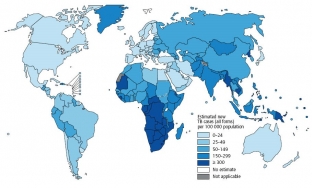Tuberculosis infection today is one of the main medical problems on the planet, because it is this disease that occupies one of the leading places in terms of prevalence among all infectious pathologies. Tuberculosis – This is an extremely dangerous disease, the main feature of which is the ability to cause pathological changes in completely different tissues and organs of the human body. The best protection against TB infection is timely vaccination of newborns against TB. Nevertheless, every year more and more new cases of this pathological process continue to be detected. How does infection with tuberculosis occur? read on.
Sources, mechanisms and routes of transmission of tuberculosis infection
The science of epidemiology deals with the prevalence of a particular infectious disease. And the specific mechanism that determines the occurrence of an infectious process among the population is called an epidemic process. Tuberculosis infection is a very widespread infectious disease, the epidemic issues of which are especially relevant for our country, where an epidemic of tuberculosis has been registered since 1995. In the structure of the epidemic process of tuberculosis infection, there are three main links necessary for infection: the actual source of the infection, the mechanisms and ways of its transmission, as well as the susceptible organism.
TB infection:
- sources of infectious agents in tuberculosis infection;
- mechanisms and routes of transmission of tuberculosis infection;
- what determines the level of susceptibility of the body to tuberculosis infection.
Sources of infectious agents in TB infection
In tuberculosis infection, the source of infectious agents is most often a person who has pulmonary tuberculosis, or animals, which is much less common. Mycobacterium tuberculosis or Koch's bacillus can be released into the environment by a person who has an open form of tuberculosis infection. Most often, these spreaders are patients with pulmonary tuberculosis who have inflammatory changes and decay cavities in the lungs. One such patient can shed up to 7 billion Mycobacterium tuberculosis in just a day. Animals, more often cattle, can also get TB and spread the infection, but workers who are in constant contact with such animals are most at risk. Of course, in large cities, this source of infection is extremely rare.

From the source of infection to the susceptible organism, the infectious agent, namely Mycobacterium tuberculosis, can get in different ways. Tuberculosis infection is characterized by 4 ways of transmission of infectious agents:
- airborne transmission: the most common route of transmission for TB. When a person with an open form of tuberculosis sneezes, coughs or talks, particles containing Mycobacterium tuberculosis enter the air, and the infection can disperse about a meter from the patient. Thus, it is possible to become infected with tuberculosis even just by being in public transport or some other crowded place;
- The alimentary route of transmission involves contracting tuberculosis infection by eating foods infected with Mycobacterium tuberculosis. Such products are meat or dairy products from an animal infected with tuberculosis that have undergone insufficient processing before consumption. Tuberculosis infection in this way is much less common, since Mycobacterium tuberculosis is very sensitive to the effects of acidic gastric juice;
- The contact route of transmission is even rarer and most often a problem of medical personnel who have direct contact with a person with tuberculosis, or the corpse of a person who died from this pathology. The contact route implies the penetration of the infection through the skin;
- The intrauterine route of transmission of tuberculosis infection is carried out due to a specific lesion of the placenta in pregnant women with disseminated tuberculosis, or during aspiration of infected amniotic fluid to newborns.
A susceptible organism is a person who acquires tuberculosis infection by any of the above routes. The likelihood of developing a tuberculous process in different people is determined by factors such as:
- massive infection;
- duration of contact with the source of the infectious process;
- input routes of infection;
- resistance state of the organism.






Add a comment